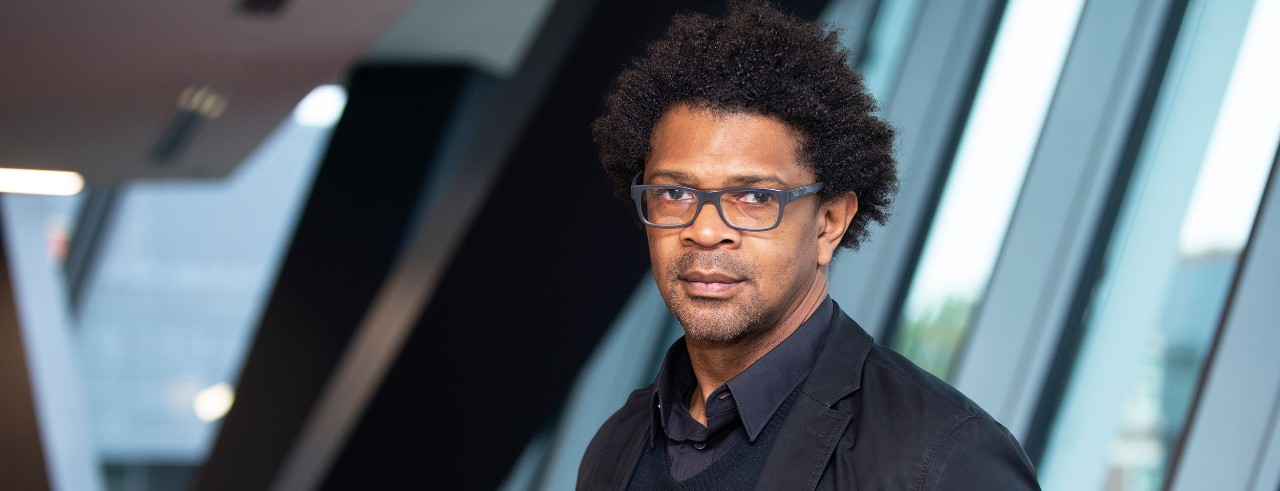
UC Answers: How does UC replicate the design studio experience online?
DAAP professor discusses how he makes his normally in-person hands-on courses virtual
Stephen Slaughter is an assistant professor in the University of Cincinnati’s College of Design, Architecture, Art, and Planning. This year, like so many instructors, Slaughter had to shift gears in his classes in DAAP’s School of Architecture and Interior Design to accommodate online learning.
Slaughter shares how he adapted his studio classes for a virtual environment.
What do your classes typically look like?
Before the COVID-19 pandemic, the majority of my classes were studios, which meant the students had a dedicated space available to them to work in 24 hours a day, seven days a week. I would meet them in their space for class, leave, and they would stay and continue working.
I instruct maybe 10% of the information — 90% comes from their own work, their own investigation and their relationship with their peers. So collaborative work is a way the students rely upon and learn from each other and keep a culture within the studio.
Pre-COVID-19, given the type of project-based studio learning that the architecture school sponsors, work would shift fluidly from the production of virtual, digital models to actual, physical models for both the investigation and representation of the students’ design ideas. Both techniques benefit from in-person demonstration, and in some cases the demonstration was held in the college’s Design Build Lab.
How did you adapt your studios and other hands-on courses for online learning?
Most production switched from physical model-making and prototyping to virtual.
The sketch capabilities of Zoom, a video conferencing application, has been invaluable. And Miro, a virtual collaborative whiteboard application, offers the ability to see and review work collectively.
Was there anything you tried that didn't work?
Microsoft Teams wasn’t as intuitive as other tools for video conferencing, and it did not have the same capabilities as far as sketching over work being presented.
What is your advice for DAAP instructors and others who are now teaching creative, hands-on subjects online?
In Zoom both the “annotation” tools and “breakout room” capabilities make meeting and reviewing graphic production great for large and small groups. And Miro is excellent for recreating the culture of a studio, because students can post and share their work and, in some cases, have conversations in the application about what’s being posted and how it aligns with expectations.
There are benefits of making an actual model. There are benefits of physically being in the classroom. But the tools and techniques that they’re doubling up on are the things that they need to double up on, regardless. So students are not missing a beat. It’s different, but they’re still learning a lot.
What is your advice for students? How can they set up for success?
My advice for students is to lean into these virtual learning tools and try to stay in tune with the dialogue and culture of the studio by participating. Just like in-person (or normal) learning experiences, the metric for success is often a reflection of the investment of time.
Trust the process. Do your best, because expectations are still high.
What are your takeaways from this unique time?
I know that this time is going to pass. We’ll get past this and get back in the classroom.
Although far from ideal, remote learning does have its benefits, and it’s up to all of us — students, instructors and administrators — to take advantage of them.
Featured image at top of Stephen Slaughter. Photo/Lisa Ventre/UC Creative + Brand
Learn more
Explore DAAP's programs and apply.
Find more UC Answers to your questions.
Related Stories
UC's art collection on display at the Contemporary Arts Center
January 5, 2026
University of Cincinnati leaders joined WVXU's Cincinnati Edition to talk about the university’s 200-year-old art collection, a new exhibition at the Contemporary Arts Center and the release of a companion book exploring the collection’s role in education and public engagement.
UC faculty and staff among Rising Star leadership honorees
January 5, 2026
Two UC faculty and staff members are among this year's Rising Star leadership program sponsored by YWCA Greater Cincinnati. Kelli Beecher, assistant professor in the UC College of Nursing, and Brittany Bibb, assistant director of programs and operations in the UC Division of Student Affairs, are among the emerging leaders of 2026. They were featured in the publication Movers & Makers.
What's behind the mysterious rise of migraines?
January 5, 2026
Weather patterns such as extreme heat and storm conditions have been linked to migraine attacks, and research shows those environmental conditions are becoming more common. As National Geographic recently reported, one of the leading theories behind this mysterious rise is that climate change may be playing a role.
